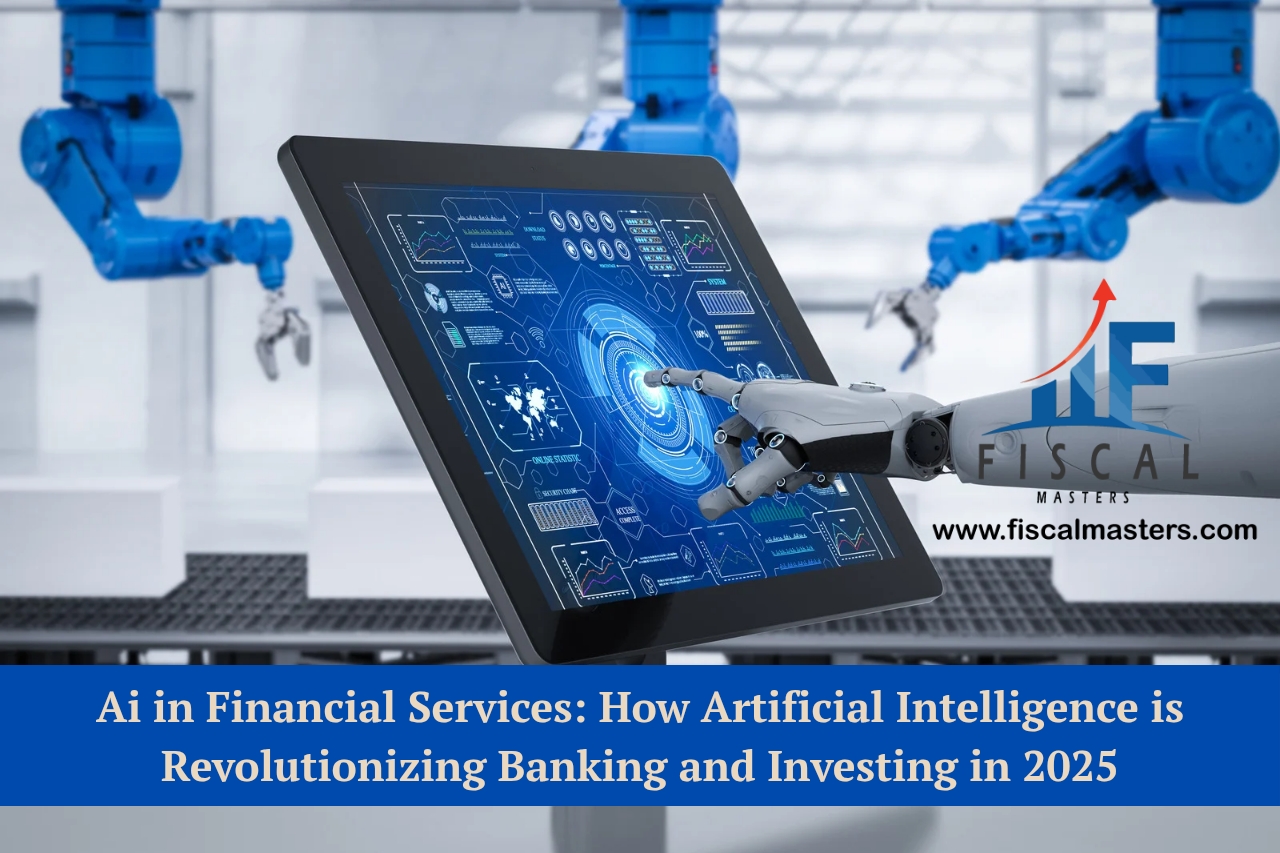Ray was a banker in Dubai. He spent countless nights reviewing loan files and fraud alerts. Then his bank introduced an AI system. A tool to help with risk analysis and customer service. Within months, loan default rates dropped. Customer satisfaction rose. Suddenly Ray had more time. He started preparing clients faster.
By 2025, Ray was speaking at fintech events. He was sharing how AI in financial services freed him from mundane tasks. That magic moment showed him that this was not just tech hype. It was the future of finance. His story is one example. But it shows how AI in financial services can transform banking jobs and improve lives.
Ray is not alone. Small business owners, retail investors, and fund managers are all gaining. Their jobs now include working side‑by‑side with AI. What once felt like sci‑fi is now everyday tools. This article explores how AI in financial services is changing banking, investing, and money management in 2025.

The Big Picture Of AI in Financial Services
AI is everywhere in banking today. It runs fraud detection. It powers chatbots. It analyzes loan risk. It also supports investment decisions. This tech has already changed how banks do business. And how consumers live.
According to McKinsey, AI could add up to $1 trillion in annual value across global banking. That is massive. When you think of AI in financial services, think of speed and safety. Every department is now using smart models.
From customer support to fraud prevention. This means fewer errors. Faster services. And better tracking of risk. This transformation helps banks stay secure and users stay happy. We’ll look at real‑world trends, new technology, and human impact.
Read more: Top 10 AI-Based Budgeting Apps For Students To Manage Their Finances – March 2024
Artificial Intelligence in Banking
Think of a bank teller who never sleeps. That’s AI chatbots. They now answer up to 80 percent of customer questions. They open accounts and reset passwords. They offer balance details. That leaves humans free to deal with complex cases.
Another key change is faster loan approvals. Ray saw this first‑hand. What once took 5 days can now take 5 minutes. How? Models analyze credit data fast. They detect fraud faster than before. Plus, regulatory checks are faster. Compliance teams now rely on AI alerts. This lowers the risk of fines or mistakes.
We also see artificial intelligence in banking improving customer fits. It goes beyond credit scores. Models weigh factors like cash flow, payment history, and behavioral trends. That helps banks serve wider groups. It makes lending fairer. We are in an age where smart decisions are fast and inclusive.
Read more: Financial Literacy For Kids: Teaching Money Management Skills From An Early Age- March 2024
AI Financial Applications That Actually Work
AI is reshaping many financial products. Robo‑advisors are one example. They build portfolios based on your goals and risk. They use machine learning in finance to adjust these portfolios. They rebalance when markets shift. This gives clients custom investment plans without high fees.
There are also systems that track fraud patterns. They scan transactions in real time. They spot odd activity and alert banks instantly. This helps stop scams before they hit your account.
Think of AI financial applications as digital helpers. They ensure your payments are safe, your portfolio is smart, and your money stays secure.
Read more: Graduate Debt-Free: Smart Financial Tips Every Student Should Know!- March 2025
Machine Learning in Finance
Imagine a system that learns from every decision. That is what machine learning in finance does. These models use huge data sets. They learn from past events and predict future needs. They spot trends before humans do.
Ray’s bank once missed early signals. Loans started defaulting unexpectedly. Now AI spots signs earlier, maybe a small payment delay or a spending dip. The system alerts loan officers right away. They can call the customer and help fix it.
In trading, machine learning tracks global data. It checks prices, news, and social sentiment in real time. Some firms use it to automate alerts or trades. It does what a human cannot track thousands of signals at once.
Read more:
AI‑Driven Financial Solutions
AI tools are smart. But they need oversight. Ray uses hybrid systems. AI approves standard loans. He handles complex cases. Sara uses an app that predicts her cash flow. It alerts her when she needs to save more. Or phone her vendor early.
That is AI‑driven financial solutions at work. These help people but don’t replace them. Usually a human reviews AI suggestions. This builds trust and avoids bias.
Read more: How artificial intelligence is reshaping the financial services industry
Fintech AI Trends 2025
What are the top fintech AI trends 2025 we see? Personalization is key. Banks now offer spending insights just for you. Recommendations appear on your mobile app.
Voice and biometric access is gaining. Users log in with a face ID or voice. This feels smoother and more secure.
Embedded finance is another big trend. Think shopping while you borrow money. Or making investments without leaving your social feed. Even De-Fi systems rely on AI to detect fraud or fix liquidity. It’s a world where finance is everywhere you are. AI is making it smarter.
AI Investment Strategies
A machine can beat human wits in investing. AI investment strategies now include robo‑advisors, quant funds, and smart dashboards. These analyze news, price trends, and macro data to suggest trades.
One platform grew investor returns by 15% in 2024. It used AI signals like sentiment, volume, and momentum. It also rebalanced weekly. This doesn’t eliminate risk. But it avoids panic selling. It removes bias. It keeps portfolios aligned with your goals.

AI in Financial Risk Management
Risk used to be slow and manual. Now it’s instant and smart. AI in financial risk management means real‑time monitoring. Liquidity, credit, and market risks are tracked across systems.
A UK insurer cut claim fraud by 37% using AI tech. It flagged abnormal claim behavior fast. Investigators stepped in early.
This helps risk teams act fast. They prevent fraud and spot liquidity gaps. They do not rely on lagging data.
Read more: The Role of Artificial Intelligence in Financial Risk Management: Saudi Perspectives
Human Impact : Real Lives, Real Change
Let’s meet three people impacted by AI. Ray the banker now spends time solving customer issues. He no longer handles routine tasks. Sara, a small business owner, uses an AI app to predict income. She plans ahead. She avoids late payments. And feels in control.
Amir in Pakistan invests using an AI robo‑advisor. He logs in twice a month and checks his dashboard. His returns are better than before.
These are everyday people shaping the future of finance. They benefit from AI in financial services. They drive trust in its potential.
Read more: Real Estate Investing: Weighing the Pros and Cons of Buying Property Real Estate Investing
When Will AI Replace Financial Jobs?
Will AI soon replace human jobs in finance? The answer is nuanced. Certain roles like routine data entry or initial loan screening are already automated. But the most advanced machines still can’t match human judgment in complex cases.
As Alex’s banker said: “We don’t see AI as a threat. We see it as a teammate that frees us to focus on strategy and relationships.” Advisors, risk analysts, and compliance officers will work alongside AI. Their roles will evolve but remain critical.
How to Prepare For Users and Professionals
If you work in finance, learn to work with AI tools. Understand how they make decisions. Ask questions. Check the data.
If you use finance tools as a consumer, ask about privacy. Find out how your data is stored and used. Choose services that are clear and fair.
Everyone should stay updated with AI trends. Learn like Ray did. Talk to experts. Adjust as models improve.
FAQS
1. What exactly is AI in financial services?
It’s when banks use software to analyze data, detect fraud, support customers, and streamline investments often without human help.
2. How is artificial intelligence in banking different from old‑school automation?
Traditional systems follow set rules. AI learns from data patterns and adapts dynamically.
3. Can AI financial applications work for small firms?
Absolutely. Even tiny businesses can use AI-powered accounting, invoicing, or risk tools via cloud platforms.
4. Does machine learning in finance really improve loan decisions?
Yes. ML considers far more variables than credit scores, leading to lower default rates and more approved loans.
5. Are AI-driven financial solutions safe for my money?
They use strong encryption and regulatory compliance. Many platforms hold outperformance records comparable to traditional advisers.

Conclusion
Financial services are already utilizing AI. We’re moving into a future where machines complement human expertise rather than replace it, as evidenced by the use of intelligent chatbots by banks and robo-advisors by investors. Finance doesn’t have to be difficult, slow, or exclusive, as demonstrated by individuals like Ray, Sara, and Amir.
Perfection is not the aim. It is a step forward. AI in financial services speeds up decision-making, reduces fraud, and personalized services. All are still actual people using AI as a potent ally to make important decisions.
Those who embrace this partnership will set the standard in 2025. The future of finance is more intelligent and secure than ever before.

